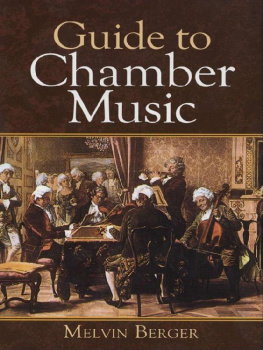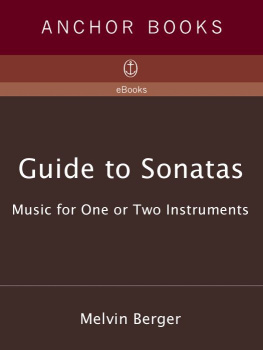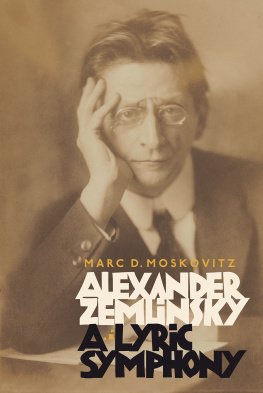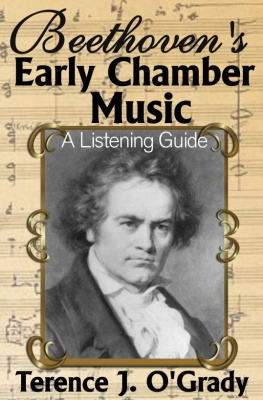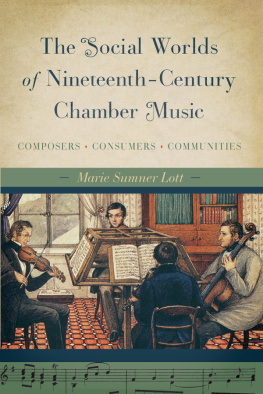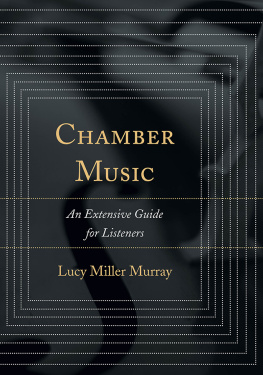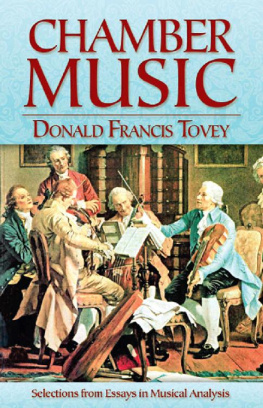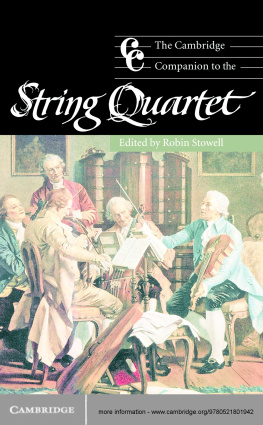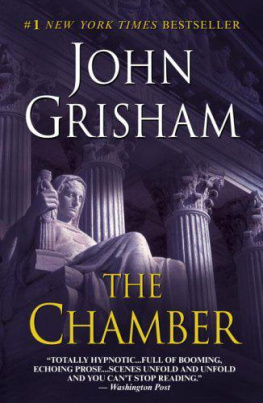Guide to
CHAMBER MUSIC
Third, Corrected Edition
Melvin Berger
DOVER PUBLICATIONS, INC.
Mineola, New York
For Gilda,
with all my love
Copyright
Copyright 1985, 1990, 2001 by Melvin Berger
All rights reserved.
Bibliographical Note
Melvin Bergers Guide to Chamber Music was originally published in hardcover by Dodd, Mead & Company in 1985, and reprinted in 1990 as an Anchor Book edition by Bantam Doubleday Dell Publishing Group, Inc. The present Dover edition, first published in 2001, is a corrected reprint of the Anchor edition. A few errors have been corrected without comment, and the original, now obsolete, discography omitted.
Library of Congress Cataloging-in-Publication Data
Berger, Melvin.
Guide to chamber music / Melvin Berger.3rd, corr. ed.
p. cm.
Discography: p.
ISBN-13: 978-0-486-41879-7 (pbk.)
ISBN-10: 0-486-41879-0 (pbk.)
1. Chamber musicHistory and criticism. 2. Chamber musicAnalysis, appreciation. I. Title.
ML1100 .B45 2001
785.009dc21
2001028648
Manufactured in the United States by Courier Corporation
41879004
www.doverpublications.com
Contents
I WROTE this book to help music loversneophytes as well as experienced concert-goersdeepen their understanding and enhance their enjoyment of chamber music. At the same time, I hope to provide a unique, practical sourcebook for chamber music players, performers, and teachers.
The book presents 231 of the best-known and most frequently performed pieces of chamber music by fifty-five outstanding composers, arranged alphabetically by composer. For each composer there is a brief biography, followed by discussions of the individual compositions, which are presented, with some few exceptions, in chronological order. In instances where composers conceived works in a group, such as Beethovens String Quartets, Op. 59, Nos. 1, 2, and 3, I offer a short description of the common features before considering the separate pieces more fully. Generally speaking, each composition is first set in a historical and musical context, and then the salient features of the music are discussed, including its formal organization, musical content, and any extra-musical associations. For the most part, I avoid technical terms; the few unfamiliar words I use for reasons of clarity or efficiency are defined in the Glossary.
Obviously, an attempt to provide a comprehensive guide to chamber music within a book of manageable length presents many problems of selection. I exchanged ideas and opinions with many leading chamber players, read through stacks of concert programs and repertoire lists, consulted bibliographies of published chamber music, and researched record catalogs of the last several years. When the time came to formulate the final contents, I incorporated this information into my own thoughts, derived from many years of chamber music playing, teaching, and writing, to compile what I believe is a complete, balanced list.
In the process I followed a few specific guidelines: to cover all types of instrumental chamber music, for modern string, woodwind and brass instruments and piano; to confine my selections to works for three to eight players; and to include as many significant contemporary composers as possible. I present the results knowing that, despite my best efforts, I may have omitted certain composers or compositions that others consider essential. If so, I can only offer my assurance that the decisions were not made lightly or without due consideration.
Over the years, it has been my privilege to be intimately involved with chamber music and to experience the exceptional pleasure and happiness that derives from this very special form of music. I will be specially gratified if this book succeeds in bringing to others the same joy, inspiration, and deep satisfaction that perceptive listening can generate.
IT IS virtually impossible to thank all those who have contributed to the writing of this book. I would like, however, to express my sincere appreciation and gratitude to: Elliott Carter, Aaron Copland, George Crumb, Leo Kraft, Ezra Laderman, George Rochberg, Gunther Schuller, and Elie Siegmeister, who were kind enough to check the entries dealing with their lives and music for factual accuracy; to Mark Shuman (Composers String Quartet), William Stone (formerly Kroll Quartet), Jack Rosenberg (Cremona String Quartet), Karl Kraber (Dorian Wind Quintet), and Robert Biddlecome (American Brass Quintet), who provided me with especially valued ideas and insights; to my colleagues in the Metropolitan String Quartet and Connoisseur Chamber Ensemble (Carol Feuer, Joyce Liebman, Susan Rubner, Albert Stwertka, and Louise Stone), who offered much help and support; to William Rorick and the staff of the Music Library of Queens College, City University of New York, and the staffs of the Research Division, Music Library at Lincoln Center, the Great Neck Library, and the C. W. Post College Library, for their skillful assistance; and to Barbara Sand and Benjamin Dunham of Chamber Music America for their advice and encouragement.
Guide to
CHAMBER MUSIC
Born July 12, 1861, at Novgorod, Russia
Died February 25, 1906, at Terioki, Finland
ANTON ARENSKY was a composer, a professor at the Moscow Conservatory and music director of the Imperial Chapel in Saint Petersburg. His music is particularly interesting for the traces one hears in it of the two opposing streams that flowed so vigorously in late nineteenth-century Russian music. One influence was Rimsky-Korsakov, Arenskys teacher at the Saint Petersburg Conservatory, and a member of The Five, the group of nationalistic Russian composers who strongly advocated the use of native folk melodies and rhythms in concert music and rejected the view that folk music is not a fit subject for serious musical composition. The other was Tchaikovsky, who was far less concerned with expressing the Russian national character and declared that his music was modeled on the style of Mozart and the Italian opera composers.
In addition to his highly successful Piano Trio No. 1, Arenskys other chamber compositions include String Quartet No. 1, Op. 11 (1888); String Quartet No. 2, Op. 35 (1894), originally for violin, viola, and two cellos, but later transcribed for the more traditional combination; Piano Quintet, Op. 51 (1900); and Piano Trio No. 2, Op. 73 (1905).
I. Allegro moderato. II. Scherzo: Allegro molto. III. Elegia: Adagio. IV. Finale: Allegro non troppo.
Arensky is not generally considered an important figure in the history of music. Yet his First Piano Trio is among the more popular and appealing works in the chamber music repertoire. Little is known about the circumstances of its composition beyond the fact that he wrote it in 1894 and dedicated it to the memory of Karl Davidoff (18381889), first cellist of the Saint Petersburg Opera and later director of the Saint Petersburg Conservatory.
Over a murmuring triplet figure in the piano, the violin sings a flowing first theme that seems to have drawn its inspiration from Tchaikovsky. After an agitated transition, the cello is entrusted with the somewhat more vocal second theme. The tempo picks up for the forceful, vigorous concluding theme of the exposition. The following, richly Romantic development section is mostly concerned with the opening theme. The recapitulation brings back all three themes, little changed from the exposition. A slow, quiet coda, really an augmentation of the principal theme, fades out at the end.
The Scherzo pits a florid, virtuosic piano part against extremely spare writing for the strings. A folk influence can be heard in the slightly slower middle section, a lilting waltz with a Slavonic cast. Here the piano is relegated to the role of accompanist as the strings weave their strands of sound into the appealing waltz melody. The movement is rounded off with a slightly expanded return of the Scherzo.
Next page
